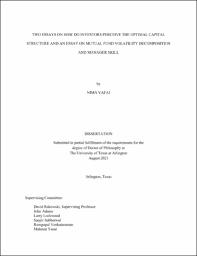
ATTENTION: The works hosted here are being migrated to a new repository that will consolidate resources, improve discoverability, and better show UTA's research impact on the global community. We will update authors as the migration progresses. Please see MavMatrix for more information.
Show simple item record
| dc.contributor.advisor | Rakowski, David | |
| dc.creator | Vafai, Nima | |
| dc.date.accessioned | 2021-09-14T15:31:55Z | |
| dc.date.available | 2021-09-14T15:31:55Z | |
| dc.date.created | 2021-08 | |
| dc.date.issued | 2021-08-02 | |
| dc.date.submitted | August 2021 | |
| dc.identifier.uri | http://hdl.handle.net/10106/29995 | |
| dc.description.abstract | This dissertation explores the rational investment hypothesis proposed by classical theories at the stock and portfolio (mutual fund) level. My first two essays focus on the risk associated with the composition of debt and equity at the firm level. The third essay studies the total risk at the portfolio level in the mutual fund setting.
In the first essay, we examine the association between deviations from the optimal capital structure and firm-level stock returns by comparing different proxies for optimal capital structure from the literature and constructing improved industry-specific optimal capital structure measures. After comparing the performance of each measure, we use a partial adjustment model to study how firms reduce their gap from optimal leverage.
In the second essay, we model firms’ deviations from the optimal capital structure as a new risk factor in the cross-section of stock returns. Using Monte-Carlo simulations to conduct bootstrapped mean-variance spanning tests, we examine whether the existing Fama and French factors can explain this potential new risk factor. We also use Text Network Industry Classification (TNIC) to show whether the new risk factor is robust to alternative industry classification.
In the third essay, we use a volatility decomposition to identify the underlying sources of differences in the performance of low and high-volatility mutual funds. We then examine whether the difference in performance is fund-specific and due to the manager’s skill, or it is a broad characteristic of market volatility. Last, we show how the difference in the performance of low and high volatility mutual funds is related to the existence of a beta anomaly in the mutual fund industry. Furthermore, we examine the idiosyncratic volatility relation with beta and risk-adjusted return (alpha) at the fund level. | |
| dc.format.mimetype | application/pdf | |
| dc.language.iso | en_US | |
| dc.subject | Capital structure | |
| dc.subject | Stock returns | |
| dc.subject | Risk factors | |
| dc.subject | Factor models | |
| dc.subject | Leverage | |
| dc.subject | Mutual funds | |
| dc.subject | Volatility | |
| dc.subject | Manager skill | |
| dc.subject | Anomaly | |
| dc.subject | Market efficiency | |
| dc.title | TWO ESSAYS ON HOW DO INVESTORS PERCEIVE THE OPTIMAL CAPITAL STRUCTURE AND AN ESSAY ON MUTUAL FUND VOLATILITY DECOMPOSITION AND MANAGER SKILL | |
| dc.type | Thesis | |
| dc.contributor.committeeMember | Lockwood, Larry | |
| dc.degree.department | Finance | |
| dc.degree.name | Doctor of Philosophy in Business Administration | |
| dc.date.updated | 2021-09-14T15:31:56Z | |
| thesis.degree.department | Finance | |
| thesis.degree.grantor | The University of Texas at Arlington | |
| thesis.degree.level | Doctoral | |
| thesis.degree.name | Doctor of Philosophy in Business Administration | |
| dc.type.material | text | |
| dc.creator.orcid | 0000-0002-8870-068X | |
Files in this item
- Name:
- VAFAI-DISSERTATION-2021.pdf
- Size:
- 1.071Mb
- Format:
- PDF
This item appears in the following Collection(s)
Show simple item record


